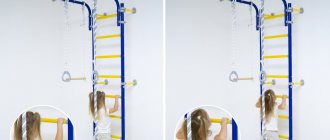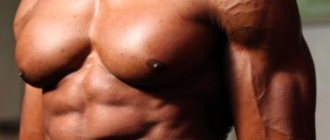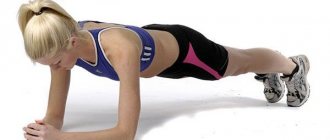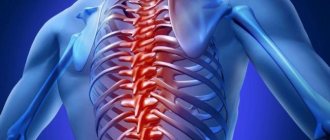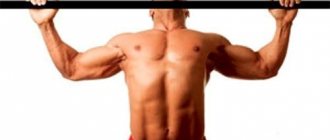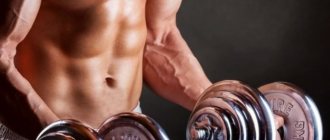Not everyone has the opportunity to exercise in a gym or specially equipped rooms when it comes to therapeutic exercises. However, there is an alternative - you can equip a wall bars at home, getting a compact corner for productive studies. Depending on the goal, a properly selected set of exercises on the wall bars will help you both lose weight and get rid of health problems.
Wall bars exercises for women and men: benefits
As the name implies, the Swedish wall was invented in Sweden, and this happened about two hundred years ago. At the beginning of the 19th century, therapist and scientist Per Henrik Ling invented his own sports system, which was called ribstool - translated as “frame with crossbars”. This projectile has become popular all over the world. He was in every school gym and medical institution in the USSR. Now the walls have become a little more compact, and at the same time more functional.
Typically, a wall bars are a ladder that is attached to the wall. You can add other equipment to it, such as a horizontal bar, parallel bars, or an inclined board. The wall is compact and can be placed in an ordinary apartment. Most of these models can easily withstand a weight of 100-150 kg, and some - up to 250 kg.
Initially, the creator of the wall positioned it as a projectile to improve health. But over time it turned out that the device is universal. It can be used by men, women, children. Using a wall bars makes it possible to achieve the following effects:
- development of strength and flexibility;
- pumping up abdominal muscles, losing weight;
- improved coordination;
- strengthening the muscles of the spine;
- general improvement in health.
On modern wall bars you can do most of the same exercises as in the gym.
Before you start practicing with the wall bars, you need to consider the following recommendations:
- You should not immediately actively hang on the wall if you have no or very weak preparation. This may cause injury. Start gradually with the simplest exercises.
- Warm up before your main workout. It may include simple exercises: squats, bends, swings. This will prepare the muscles and joints for stress.
- Before moving on to sets of exercises, first try just hanging on the wall for a few minutes.
- To begin, do exercises without a wall: standing, sitting or lying down, depending on your technique.
Exercises for weight loss on the wall bars at home
The wall bars are useful for losing weight and strengthening muscles. For this purpose, you can use the following exercises:
- Leg raises. You need to hang on the crossbar. As you exhale, slowly raise your legs as straight as you can, tightening your abdominal muscles. At the extreme point, fix your legs for a couple of seconds and slowly lower them. You need to specifically engage the abdominal muscles, not the thigh muscles. Deflections in the body are not allowed. If the exercise seems simple, you can hold a dumbbell between your legs or use special weights.
- Lateral leg raises. The situation is similar. Raise your legs alternately: left to the left, and right to the right. The limbs should be straight; hold them for a few seconds at the maximum point.
- Hanging on the bar. This exercise can be used as a warm-up. It helps develop the arms and also has a beneficial effect on the spine. You can hang for a certain time or until you get tired. In the process, you can bend, move your legs to the sides, and so on.
- Unusual hang. After hanging from the bar in the usual way, perform the scissors exercise with your legs crossed. Also, together with scissors, you can rotate the hip joint to the sides.
- Stretching all muscles. When stretching, the arms, legs, back, and abdomen are involved. You can perform it at the beginning or at the end of the complex. You need to stand sideways to the wall at a distance of about a meter from it. Throw your nearby leg onto the crossbar so that a right angle is formed between the limbs. Take your supporting leg with your hands and try to reach the floor. You need to stretch with your whole body.
- Low squats. You need to climb onto the wall with a distance of at least 30 cm from the floor surface. Grasp the bar with your hands near your elbows and squat as low as possible. The exercise involves the buttocks, arms and back.
- Abdominal pumping. You can pump up your abs with this exercise while hanging or off the floor. While hanging, raise bent or straight legs to the chest. The second option suggests that you need to lie on the floor, grab the crossbar below with your feet and do body lifts.
- Tilts. The position is the same as when stretching, but you need to bend over and straighten up in turns. The back should remain straight.
- "Stork". Position as for stretching. But you need to turn away from the wall bars, and smoothly bend the stubborn leg at the knee, then straighten it. After completing 2-3 approaches, change limbs.
- "Sail". The position is similar to squats. But now your task is to arch your back like a sail and hold yourself in this position for a few seconds. You can also move the pelvic area to the sides.
What to remember
- The Swedish wall is a sports equipment that allows you to work out all muscle groups well.
- Beginners do not need to rush - increase the load gradually, initially train all movements on the floor.
- Do not forget that for real weight loss it is important not only to exercise regularly, but also to monitor what you eat by referring to the principles of proper nutrition.
Do you train on such a simulator? What are the results? Share in the comments, friends. And I say goodbye to you, until we meet again.
Back exercises on the wall bars
The wall bars perfectly help maintain the health of the spine, strengthen the back and prevent pain.
If you have certain pathologies, consult a specialist before starting training.
Pay attention to the following complex:
- The left leg is on the wall. The foot is parallel to the floor surface. Hands are placed on the bar at the shoulder line. Rotations of the lower limb are performed in the hip area 8-10 times.
- Same starting position. Spring flexions are performed in the knee joint area (5-6). Hands take hold of the crossbar. The torso must be kept stable. The foot of the active limb is located horizontally.
- From the same starting position, grab the bar on the sides of your leg with your hands. Make 8-10 bends towards the straight limb of the body without changing the position of the foot.
- Place your foot on the bar and tilt your body, resting your hands on the apparatus. Place your other foot at an angle of about 45 degrees. Pull the pelvis forward towards the wall, rotating the limb in the hip area. A deflection is performed in the lower back, and the body leans forward towards the leg, which is on the wall. The second limb then does the same.
- One leg is straightened and placed on the wall. Do 6-10 smooth springy bends with your body forward, placing your hands on the foot of this leg. When doing the last repetition, stay at the bottom for 10-15 seconds. The same is done for the second leg.
- Stand with your side to the wall, place one leg pointing to the side at a right angle on the crossbar. Make 8-10 body tilts towards the straightened second leg, trying to touch the floor with your fingers or palms. When performing the last incline, hold for 10-15 seconds. Do the same for the second limb.
- Stand facing a wall with your feet wide apart and grasping it near your chest. Make 8-10 rotations alternately inward and forward with both legs at the hip joint, trying to spread your legs as wide as possible.
- Similar starting position. Turn to the left and lower yourself as far as you can into a split position, performing springy movements. Turn around and go into a split on the other side.
- Stand with your right side facing the apparatus and grab the bar with the same hand. Keep your feet together. Perform 10 steps forward with your left leg straightened, gradually increasing the amplitude. Then turn to the other side and repeat the same for the second limb.
- You need to stand in front of the wall. Take the bar with your right hand and place your left hand at waist level. Place your legs together and make 10 swings with one of them, tilting your body. For the other side the actions are similar.
- You need to stand with your right side to the wall, grab it with your right hand along the chest line, and with your left hand along the waist line. Lower limbs together. For each of them, 10 back swings are performed.
- Stand against the wall with your right side. Bend the leg next to you at the knee joint and place it point-blank on the bar. Grasp the projectile with your hand slightly below the knee. Spring bends with the torso forward are performed. You need to try to reach the surface with your fingers or palms. For the other leg, the manipulations are similar.
- Stand with your back against the wall. Lean on your left leg and throw the other one over the bar. Place your right hand above your leg, approximately in line with your shoulder. Bend your back and perform 10 repetitions back and forth in the hip area. The same is done for the opposite side.
- Stand with your back to the wall. Grab the step above your face and bend your lower back. body back, each time grabbing the lower bars.
Photos will help you better understand how to perform the exercises.
Safety precautions
When practicing with your child on the wall bars, follow simple rules.
- Before purchasing a wall bars and before starting home workouts, consult your pediatrician. Even such a useful sports equipment has contraindications.
- Be sure to warm up before doing the exercises: perform rotational movements with your head, shoulders, arms, and hands. Rotate your feet. Get up on your toes and go down. Do 2-3 body tilts in each direction.
- Take care of a soft landing: lay a high-quality, dense mat near the wall bars.
- Complicate the exercises and increase the number of approaches gradually. At the same time, make sure to perform the exercise correctly.
- End your workouts with a little stretching (see section above), otherwise your child will have sore muscles the next day and will not want to repeat the “unpleasant” experience.
- Don't force it! There will be little benefit from “I don’t want to” exercises.
- Don't exercise immediately after eating. Wait at least 30-40 minutes.
- Do not practice on the wall bars if your child is overexcited: concentration will decrease and the risk of injury will increase.
- Avoid exercising if you feel unwell.
- Insure your child: a child under 4-5 years old - constantly, an older child - during complex exercises and when climbing to heights.
Recommendations
To make the classes useful and effective, consider these tips:
- Start with the minimum number of repetitions. To begin with, a couple of approaches of 8-10 times is enough. Gradually the number of repetitions needs to be increased.
- Exercises that involve hanging can be done for a while, or you can just hang for as long as you can.
- If you have any health problems, then a set of exercises and the frequency of performing them should be prescribed by a doctor. For prevention, it is enough to perform them 3-4 times a week.
- The same frequency is optimal for losing weight. If you are working a specific muscle group, then keep in mind that it needs to be given time to recover for at least 3 days.
The wall bars are a universal device that can be placed at home and practiced both for your figure and for your health. It is important to adhere to the correct exercise technique. You can watch the effective complexes in the video.
Caution doesn't hurt
In general, training on such equipment is suitable for literally everyone.
The most important thing to remember to avoid injury is not to overdo it. Warm up your muscles, do regular exercises first, without walls, gradually train strength and endurance, and do not forget to rest your body.
For more effective weight loss, give each muscle group a rest for 1-2 days. According to experts, this allows subcutaneous fat to be burned faster.
Contraindications to classes
There are few restrictions during training on the wall bars. They mainly depend on the intensity of training and the selected set of exercises. General contraindications include:
- Acute infectious diseases;
- Exacerbation of any chronic pathology;
- Early recovery period of injuries and abdominal operations;
- Unstable blood pressure;
- Life-threatening arrhythmias;
- Recent myocardial infarction.
For other diseases and conditions, for example, severe osteoarthritis, varicose veins, and pregnancy, only certain exercises on the wall are contraindicated.
Peculiarities!
For example, with stage III osteoarthritis of the leg joints, static loads on the lower extremities are contraindicated, and hanging exercises and general stretching, on the contrary, help slow down the progression of the disease.
